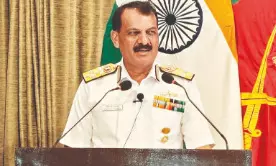Sea power reimagined: Navy Chief warns of cyber, seabed and grey zone threats

New Delhi: Chief of Naval Staff Admiral Dinesh K Tripathi emphasised that maritime conflict now extends beyond traditional domains into cyberspace and the deep seabed, where India’s critical infrastructure is increasingly exposed to modern threats.
He cited the Lab Dookhtegan cyberattack on Iranian vessels as an example of new dangers threatening global shipping and trade. With India’s reliance on sea routes for nearly 95 per cent of its commerce, he underscored the urgent need to address vulnerabilities to cyber and seabed threats.
Admiral Tripathi pointed out that it is becoming harder to know the true purpose of vessels at sea. Even small ships that look civilian can now carry advanced equipment like sonars, sensors, or missiles. He said these dual-use platforms, especially when paired with expendable autonomous systems, are ideal for ‘grey zone’ operations—actions that change situations without starting a full war. ‘Technology has collapsed the neat separation of war and peace. We now operate in a continuum of competition,’ he said.
The Naval Chief highlighted recent sabotage of undersea infrastructure like the Nord Stream pipeline and repeated attacks on submarine cables, saying the seabed is now a new battleground. He called this situation ‘weaponised interdependence,’ where technology and economic connections are used as tools of pressure. He also noted that ‘lawfare’ is becoming more common, with countries using advanced surveys and mapping to push territorial claims.
He highlighted that these evolving threats have fundamentally changed the nature of war, making adaptability and rapid technological response critical for the Navy.
The Navy Chief also explained that distributed maritime operations, where ships, submarines, aircraft, and autonomous systems work together as one network, are changing how naval warfare works. This approach lets forces combine their power without gathering all their assets in one place, making them harder to target and able to make decisions faster, following strategist John Boyd’s OODA loop for speed and adaptation.
Turning to India’s preparedness, Admiral Tripathi said combat power and readiness remain central to naval planning. The force is modernising existing platforms, inducting new capabilities, and experimenting with operations in GPS-denied environments, drone-defence systems, and carrier-borne land strikes. Earlier this year, the Navy carried out its first full-scale cyber exercise, blending digital and conventional manoeuvres.
The Navy is planning a major technology upgrade through its Vision 2047 roadmap. They are making processes simpler, using agile software development, and bringing in digital twins for training and maintenance. They are also making it possible to support systems remotely at sea. Artificial intelligence is playing a bigger role in managing logistics and inventory.
On the innovation front, the Navy is working closely with industry, academia, and startups through initiatives like the Naval Innovation and Indigenisation Organisation (NIIO) and the Technology Development and Acceleration Cell (TDAC). Over 120 startups and MSMEs are engaged on projects spanning drone swarms, autonomous underwater vehicles, and directed-energy weapons. In the last two years alone, contracts worth more than Rs 6,000 crore have been signed for indigenous solutions, while an AI Incubation Centre in Bengaluru is pursuing 60 use cases for low-cost, scalable applications.



